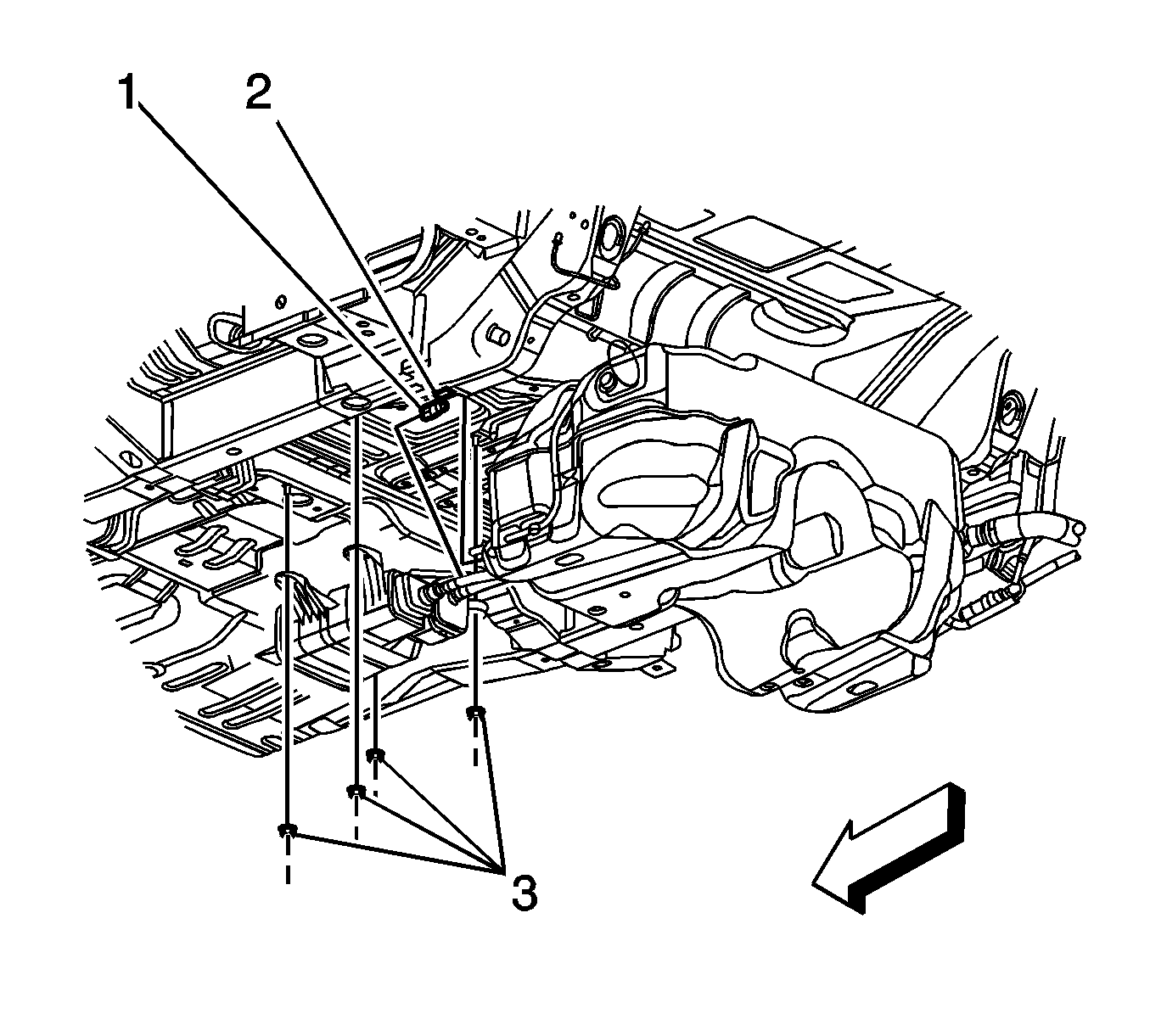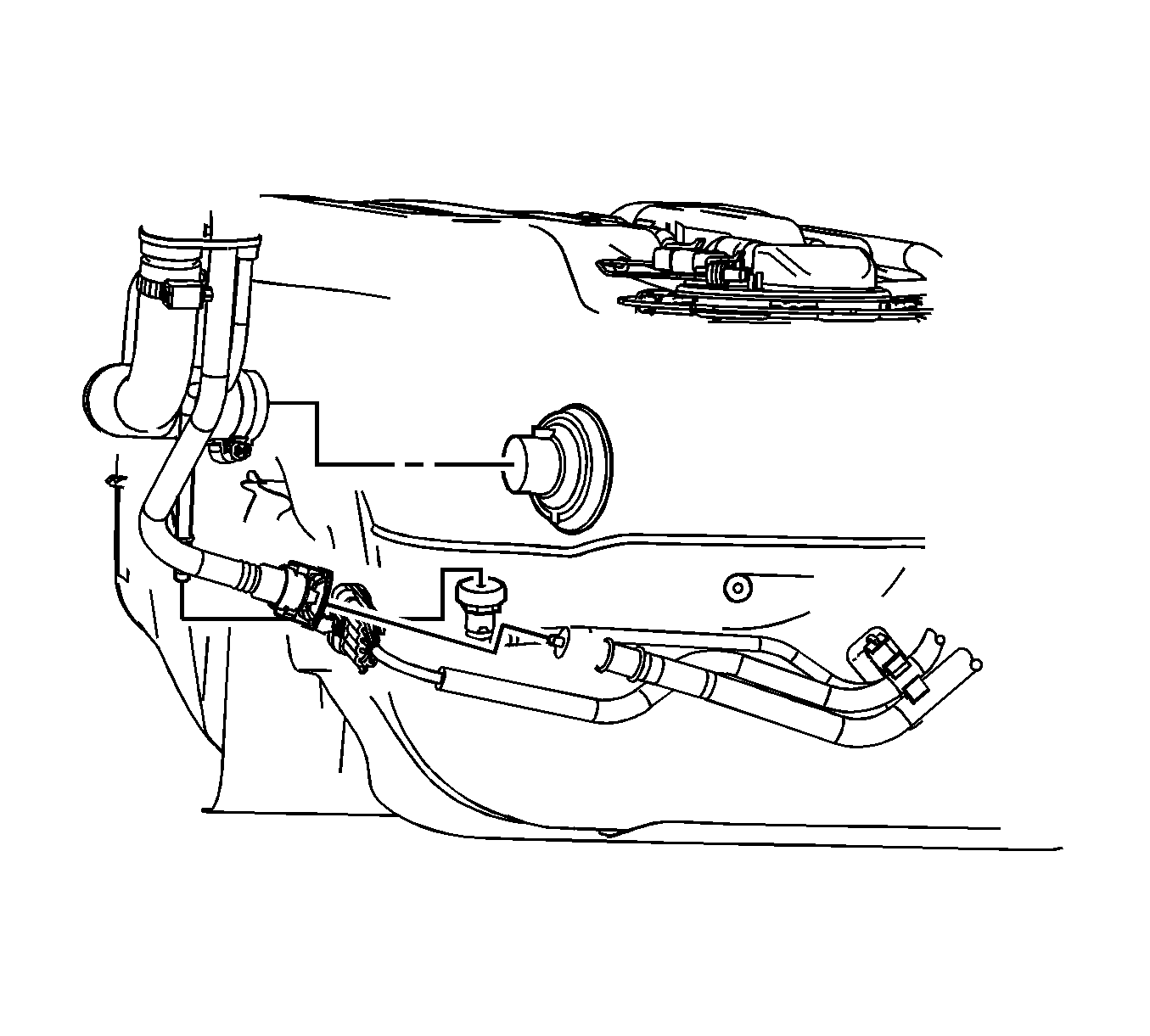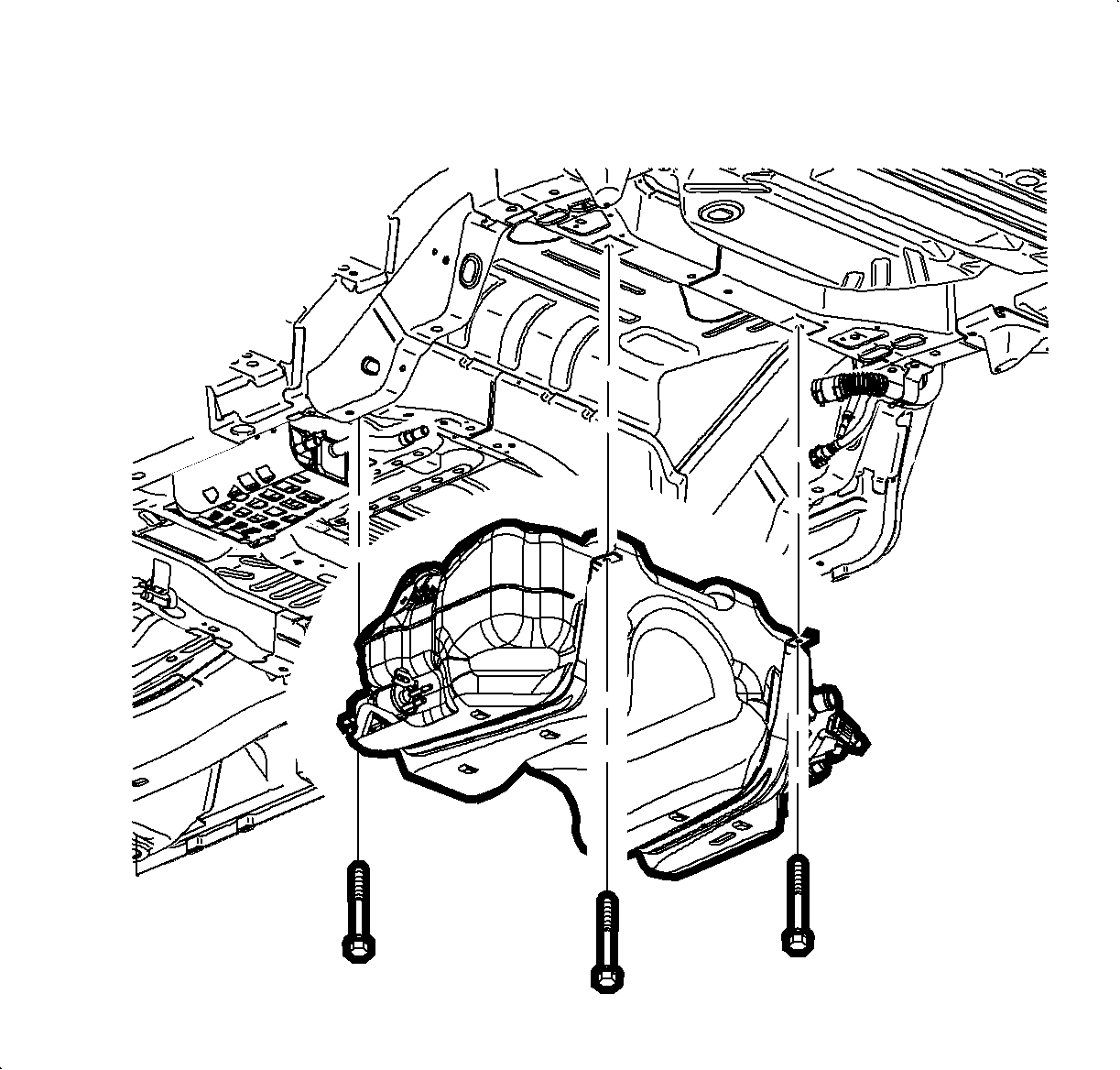Fuel Tank Replacement FWD
Removal Procedure
- Ensure that the fuel level in the tank is less than 1/4 full. If necessary, drain the fuel tank to at least this level. Refer to Fuel Tank Draining .
- Relieve the fuel system pressure. Refer to Fuel Pressure Relief .
- Disconnect the negative battery cable. Refer to Battery Negative Cable Disconnection and Connection .
- Raise and support the vehicle . Refer to Lifting and Jacking the Vehicle .
- Remove the exhaust system. Refer to Exhaust System Replacement .
- Remove the evaporative emission (EVAP) canister (4). Refer to Evaporative Emission Canister Replacement .
- Disconnect the chassis fuel supply line (2) from the fuel tank.
- Disconnect the fuel filler tube, EVAP vent hose, and fresh air hose from the fuel tank.
- Disconnect the fuel tank electrical connector and remove the electrical connector retainer from the rear frame.
- Support the fuel tank.
- Remove the fuel tank strap bolts and fuel tank straps.
- Lower the fuel tank from the underbody of the vehicle.
- If replacing the fuel tank, remove the fuel tank module assemblies. Refer to Primary Fuel Tank Module Replacement and Secondary Fuel Tank Module Replacement .
Caution: Do not allow smoking or the use of open flames in the area where work on the fuel or EVAP system is taking place. Anytime work is being done on the fuel system, disconnect the negative battery cable, except for those tests where battery voltage is required.
Caution: Fuel supply lines will remain pressurized for long periods of time after the engine is shutdown. This pressure must be relieved before servicing the fuel system.

Notice: Clean all fuel pipe connections and surrounding areas before disconnecting the fuel pipes to avoid contamination of the fuel system.
Caution: Whenever fuel lines are removed, catch fuel in an approved container. Container opening must be a minimum of 300 mm (12 in) diameter to adequately catch the fluid.


Notice: Do not bend the fuel tank straps. Bending the fuel tank straps may cause damage to the straps.
Important: Do not lower the rear frame. It is not necessary to lower the rear frame for fuel tank removal.
Installation Procedure
- If previously removed, install the fuel tank module assemblies. Refer to Primary Fuel Tank Module Replacement and Secondary Fuel Tank Module Replacement .
- Install the fuel tank heat shield and fuel tank assembly to the vehicle.
- Install the fuel tank straps and the fuel tank strap-to-body bolts.
- Connect the fuel tank electrical connector and install the electrical connector retainer to the rear frame.
- Connect the EVAP vent, and fresh air hoses to the fuel tank.
- Connect the fuel filler tube to the fuel tank.
- Connect the chassis fuel supply line (2) to the fuel tank.
- Install the evaporative emission (EVAP) canister (4). Refer to Evaporative Emission Canister Replacement .
- Install the exhaust system. Refer to Exhaust System Replacement .
- Lower the vehicle .
- Fill the fuel tank with gasoline.
- Connect the negative battery cable. Refer to Battery Negative Cable Disconnection and Connection .
- Prime the fuel system:

Notice: Refer to Fastener Notice in the Preface section.
Tighten
Tighten the bolts to 25 N·m (18 lb ft).

Tighten
Tighten the fuel filler tube clamp to 5 N·m (44 lb in).

| 13.1. | Cycle the ignition ON for 5 seconds and then OFF for 10 seconds. |
| 13.2. | Repeat the previous step twice. |
| 13.3. | Crank the engine until it starts. The maximum starter motor cranking time is 20 seconds. |
| 13.4. | If the engine does not start, repeat steps 13.1-13.3. |
Fuel Tank Replacement AWD
Removal Procedure
- Ensure that the fuel level in the tank is less than 1/4 full. If necessary, drain the fuel tank to at least this level. Refer to Fuel Tank Draining.
- Relieve the fuel system pressure. Refer to Fuel Pressure Relief.
- Disconnect the negative battery cable. Refer to Battery Negative Cable Disconnection and Connection.
- Raise and support the vehicle. Refer to Lifting and Jacking the Vehicle.
- Remove the exhaust system. Refer to Exhaust System Replacement.
- Remove the propeller shaft. Refer to Propeller Shaft Replacement.
- Place a suitable container under the fuel line connection in order to catch any dripping fuel.
- Disconnect the chassis fuel supply line (2) from the fuel tank.
- Disconnect the fuel filler tube, EVAP vent hose, and fresh air hose from the fuel tank.
- Disconnect the fuel tank electrical connector and remove the electrical connector retainer from the rear frame.
- Support the fuel tank.
- Remove the fuel tank strap bolts and fuel tank straps.
- Lower the fuel tank (with shield) from the underbody of the vehicle.
- If replacing the fuel tank, remove the fuel tank module assemblies. Refer to Primary Fuel Tank Module Replacement and Secondary Fuel Tank Module Replacement.
- If replacing the fuel tank, remove the heat shield from the tank.
Caution: Do not allow smoking or the use of open flames in the area where work on the fuel or EVAP system is taking place. Anytime work is being done on the fuel system, disconnect the negative battery cable, except for those tests where battery voltage is required.
Caution: Fuel supply lines will remain pressurized for long periods of time after the engine is shutdown. This pressure must be relieved before servicing the fuel system.

Caution: Whenever fuel lines are removed, catch fuel in an approved container. Container opening must be a minimum of 300 mm (12 in) diameter to adequately catch the fluid.
Notice: Clean all fuel pipe connections and surrounding areas before disconnecting the fuel pipes to avoid contamination of the fuel system.


Notice: Do not bend the fuel tank straps. Bending the fuel tank straps may cause damage to the straps.
Installation Procedure
- If previously removed, install the fuel tank module assemblies. Refer to Primary Fuel Tank Module Replacement and Secondary Fuel Tank Module Replacement.
- If previously removed, install the heat shield to the fuel tank.
- Install the fuel tank heat shield and fuel tank assembly to the vehicle.
- Install the fuel tank straps and the fuel tank strap-to-body bolts.
- Connect the fuel tank electrical connector and install the electrical connector retainer to the rear frame.
- Connect the EVAP vent, and fresh air hoses to the fuel tank.
- Connect the fuel filler tube to the fuel tank.
- Connect the chassis fuel supply line (2) to the fuel tank.
- Install the propeller shaft. Refer to Propeller Shaft Replacement.
- Install the exhaust system. Refer to Exhaust System Replacement.
- Lower the vehicle.
- Fill the fuel tank with gasoline.
- Connect the negative battery cable. Refer to Battery Negative Cable Disconnection and Connection.
- Prime the fuel system:

Notice: Refer to Fastener Notice in the Preface section.
Tighten
Tighten the bolts to 25 N·m (18 lb ft).

Tighten
Tighten the fuel filler tube clamp to 5 N·m (44 lb in).

| 14.1. | Cycle the ignition ON for 5 seconds and then OFF for 10 seconds. |
| 14.2. | Repeat the previous step twice. |
| 14.3. | Crank the engine until it starts. The maximum starter motor cranking time is 20 seconds. |
| 14.4. | If the engine does not start, repeat steps 14.1-14.3. |
